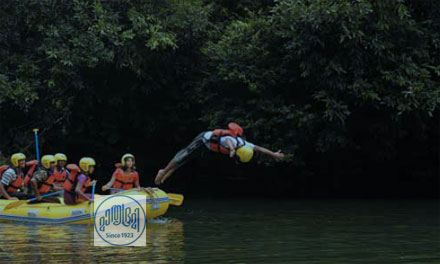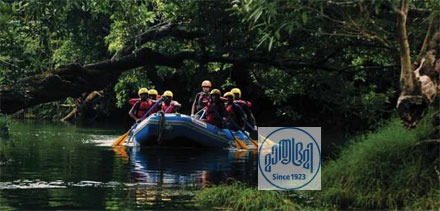Torrential spills and thrills
Chasing Monsoon/ Tejaswini/ Rafting
In pursuit of the rain…on the waves of adventure. Rafting during the rains is now gaining popularity in Kerala too. A daring venture through the Tejaswini River in North Kerala.

Tejaswini was hysterical… her cries could be heard from far. The long wait for the arrival of the rain, her lover, had turned into grief. Shaking her body, her hair let loose, hands outstretched, she took out all her grief, on the rocks. A magnetic charm permeated this amorous woman…
Fourteen of us set out in two inflated boats... I slowly turned back to look at them. Their lively chatter had come to a halt. They looked pale as if blood had drained from their faces. The paddles seemed to be slipping away… my grip tightened further around the paddle… my courage was draining away! Within seconds, Tejaswini pulled us into her bosom. Instantly, screams arose from the boat. Her frenziness had diffused into us …

Tejaswini is the waterline that divides Kannur and Kasargod into two. Our trip to Cherupuzha was in quest of extreme adventure, to experience the daring sport of 'rafting', that we get to see only in the National Geographic and Discovery channels…Crossing over the new bridge in Cherupuzha, we set out in our inflated boats from Kolladi in Kasargod. We slowly lowered our paddles into the river. Within seconds, the rafts were swept away, like catamarans caught in the floods.
The instructions and reprimands of the Nepali guides got drowned in Tejaswini's roar. The currents became stronger and stronger. Bats flew out of the mangrove forests along the river, forming circular patterns in the black sky, with their huge wings spread out. The screeching of the bats, the roaring sound of Tejaswini as she lashed herself against the rocks, all together created a mood typical of a horror film!
The raft almost hit a rock…my heart was in my mouth… Seeing the plus 2 students Sheba and Pooja in the raft, I tried to hide my fear.

The Nepali guides, Sanjeeb and Rajusreshta, were humming some Nepali songs. They were in Kerala to give training in rafting. Suddenly, the raft in front swerved, spinning like a top. It hit a huge tree that had fallen into the turbulent river, and stopped. We climbed up, clutching the rock on which the trunk of the tree rested. With the rope in the raft, the guide dived into the roaring river. Swimming against the strong currents, he tied the rope tightly to a tree on the opposite bank. We looked on, holding our breaths, at the Nepali's daring act. All of us jumped back into the raft as soon as it was freed from the clutches of the tree. Our companions, Aabeed and Binu had to swim some distance before they were able to climb in.
We went past the forests of Kasargod and Kamballur to reach Chemmaramkayam, the deepest point in the river at Chemmaram. We were again caught in the swirl of the current. We struggled to keep our heads from hitting the drooping branches. As we slowly tried to raise our heads, Aabeed, who was sitting in front, suddenly cried out loudly, 'duck down. A snake!' A snake lay coiled amidst the thick foliage. 'Kya Cobra hai?' the Nepali asked amazed. 'Hey! This is some other breed… will drift away in the next shower', someone replied.
During heavy rains, Tejaswini breaches both the banks. Then, nothing can pass through the Chemmaram kayam without getting caught in its swirls. From the hanging bridge above, many watched us with amazement. Gradually the current weakened. Tejaswini attains her true form as she enters Kasargod. Our five hour long 'drift' (our journey can also be described so) stretching over 12km came to an end at Kakkadavu in Kasargod. Even as we were walking back to the jeep, we couldn't help ourselves from turning back to look again at Tejaswini… our hearts were hesitant to bid adieu… at night, as we lay down closing our eyes, we drifted into sleep on Tejaswini's bosom, her distant sounds resounding in our ears…

Safe Rafting
White water rafting is a recreational sport that requires great courage. Unless proper precautions and preparations are taken, it is very likely that this sport can turn disastrous. Before venturing out into this trip, have a clear understanding with the raft operators about the safety rules and regulations. Natural obstacles and failure to follow the guide's instructions invite accidents. The safest option is to be under the guidance of an expert. Before setting out, make sure that the guide has a valid license.
* Intoxicants should be avoided.
* Follow the guide's instructions
* If there are strong currents and rocks and boulders along the course, don't stand up while rafting.
* Be alert. Don't invite accidents because of your carelessness.
* Knowing swimming is preferable.
Safety equipments
* Life- jacket – for rescue if you fall into the water
* Helmets – because you encounter rocks and boulders en route.
* Throw bag- strong rope or a rope filled bag. To save oneself if the raft goes out of control.
* Repair kit- to repair any damage caused to the raft on the way.
* First Aid Box
In India, rafting is very popular in Ladakh, Himachal, and the Uttarkhand ranges. In Kerala, it is slowly gaining popularity. Rafting operators are few. Depending on the strength of the current and other obstacles involved, rafting has been categorized into 6 classes. Of these, the most dangerous belong to the Class-6 category. However, rivers in India very rarely fall in this category. The rafting through the Tejaswini River can be classified under class-2 or class-3 category and in times of turbulent flow, it can go up to class-4. When the currents are weak, even kids who can use life jackets can be taken along with the family.
Travel Info: Rafting along Tejaswini
A popular adventure sport worldwide. Rafting organizers are rare in Kerala. Extreme Rafting at Cherupuzha (Kannur) conducts rafting tours in Tejaswini River.
Location:
Kannur district. Cherupuzha, Tejaswini River, on Kannur-Kasargod border. 65 km from Kannur and 35 km from Payyanur.
How to reach:
By road: Buses available from Kannur to Payyannur (40km- 1.15 hrs, Rs.21.00). From Payyannur (Old bus stand) to Cherupuzha (1 hr, Rs. 17.00). From Cherupuzha town by auto to Xtreme rafting's starting point, at Kollada (4km)
Alternative route: Kannur-Thaliparamba (21km)-Alakkode (25km)- Cherupuzha (22km).
By rail: Payyannur railway station (35km), Kannur (65km)
By air: Mangalore (145 km), Calicut (160km)
Contact:
Shyju Sebastian, Xtreme Rafting, Cherupuzha. Mob: +91-9495325669
Payyannur Railway Station: 0498-5203078
Kannur Railway Station: 0497-2705555
Best Season
June, July, August. If monsoon lasts longer, from September to mid-October rafting possible.
Stay:
Medium range accommodation available at Cherupuzha. Aradhana residency, near Cherupuzha bus stand. Tariff range Rs.100-Rs.275, Ph: 04985-241385. For class A/C accommodation stay at Kannur, Thaliparambu or Payyannur. Xtreme Rafting organizers provide accommodation for small groups.
Rafting Packages:
Rafting charge: Rs.850/head (10km rafting/two hours). Xtreme rafting provides six packages for tourists. Details at: www.xtremerafting.co.in



No comments:
Post a Comment